
scrounge: /skrounj/ informal verb: to actively seek [books] from any available source
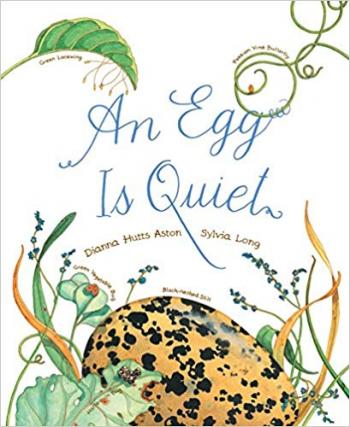
An Egg Is Quiet is the latest book we've read from this stellar author/illustrator team, and we found it just as informative and packed with details and lovely pictures as the last two (A Seed Is Sleepy -- review; and A Rock Is Lively -- review).
So many eggs have such interesting patterns and beautiful combinations of earth tones with the occaional bright color, and the illustrations here capture it all so beautifully. My children and I enjoyed just looking at the double-page spread before the title page that features pictures of different eggs, seeing how they compared to each other and reading which animals each would hatch into.
I tend to think of eggs as belonging to the domain of birds, and the majority here do, but we also see the ways that insect eggs, amphibian eggs, and reptile eggs compare to these. A nice chart at one point shows gestation times for a few different kinds of animals, with a few pictures of the insides of the eggs at different stages.
I like the page that contrasts the shapes of eggs, and how each shape works best for the type of environment the egg is in -- for example, the oblong seabird egg that's wider at one end than the other, which helps prevent it from rolling off the edge of the cliff if it's bumped.
I love how the poetic language feels simple and gentle, yet communicates so much! Definitely a keeper.
Scrounged From: Amazon
Format: Paperback
Author: Dianna Hutts Aston
Illustrator: Sylvia Long
Pages: 36
Content Advisory: None
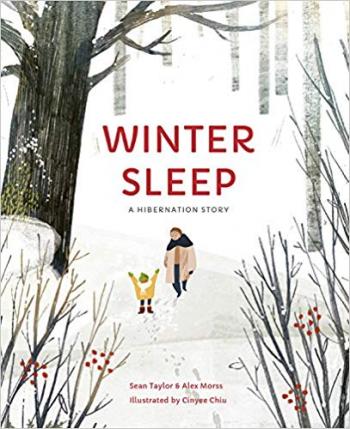
Winter Sleep uses a story of a boy who visits his grandmother as a framework to describe some of the ways that many woodland animals hibernate during the winter. The book begins with a brief look at some animals in their wide-awake forms during summer, before contrasting this with the colder and quieter winter scene.
I enjoyed the illustrations that use plenty of earthy colors to show pond life, smaller animals like mice and insects, as well as larger animals like bears as they take their winter rest. The "story" itself is a bit sparse, but serves well enough as a more conversational way to present the information.
This reminded me a bit of Over and Under the Snow (see my review here). It's less poetic, but contains more informational pages at the end. It also refers to bugs as "minibeasts" which I thought was an amusing term -- I assume it's a British convention.
Scrounged From: NetGalley
Format: Kindle
Authors: Sean Taylor and Alex Morss
Illustrator: Cinyee Chiu
Pages: 32
Content Advisory: None
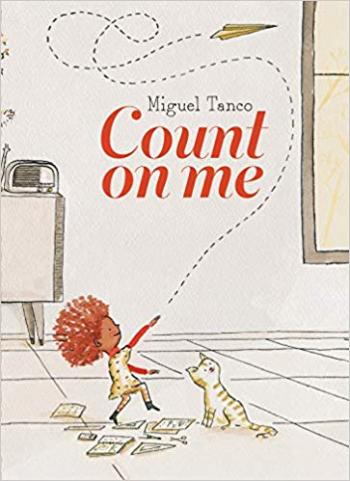
The unnamed girl in Count on Me begins by telling us that everyone has a passion. She shows some of her family members' passions, as well as some of the things she tried that just weren't for her. Then she reveals what her passion is: math. She enjoys looking for it in the world around her, in the form of geometric playground equipment, concentric circles in the water, etc. While this section of the book doesn't go into a lot of detail about mathematical concepts, it serves to present math as a way of seeing the world, as well as to normalize it as something for a girl to do.
At the end of the book, there are several pages describing in more detail how to look for different kinds of math in the real world: fractals, projections, polygons, etc. This section was helpful and gives a more tangible picture of how ubiquitous math is when you know how to look for it. (Despite the title, counting isn't really discussed here.) We enjoyed this book very much, and the watercolor art is beautiful.
(In compliance with FTC guidelines, I disclose that I received this book for free through LibraryThing Early Reviewers. I was not required to write a positive review.)
Scrounged From: LibraryThing
Format: Hardcover
Author/Illustrator: Miguel Tanco
Pages: 48
Content Advisory: None
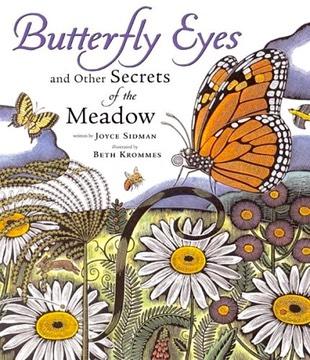
We enjoyed Joyce Sidman's nature poetry in Winter Bees (review here), and were glad to find another collection with a spring theme in Butterfly Eyes and Other Secrets of the Meadow, which we read to finish out the school year this year.
These poems also work as riddles. Each page contains two poems about different aspects of nature in the meadow -- sometimes rodents or bugs, but other times nonliving things like sun and rain. The two answers to the riddle are connected somehow (and described in prose on the page after each riddle), sometimes in more obvious ways than others (butterflies and milkweed, for example), but overall this book helps to show the interconnectedness of all parts of nature when they inhabit the same environment.
The illustrator here is the same as in Swirl by Swirl (review here), but I think the colors are lighter and brigher, and the contrast of the dark lines makes them stand out all the more.
A lovely investigation into nature in spring!
Scrounged From: A used book sale
Format: Hardcover
Author: Joyce Sidman
Illustrator: Beth Krommes
Pages: 48
Content Advisory: None
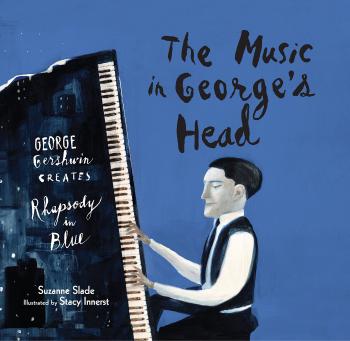
While living in the UK, my family somehow acquired a cassette tape (yes, this was in the 90s) at a gas station (or petrol, as they called it there) called "Miles of Classical." It contained several well-known orchestral pieces of music, including Strauss's "Blue Danube," a movement from Tchaikovsky's "Swan Lake," and, the fifth and last piece on side 1 of the cassette, George Gershwin's "Rhapsody in Blue," or at least an abbreviated version of it.
Other than "The Nutcracker," I didn't have much love for orchestral music, but listening to that cassette over and over and over on long drives really helped me and my siblings to develop more appreciation for some of these favorites. I'm still not sure I really "understand" jazz music, but Gershwin's piece was definitely my favorite on that cassette. It reminded me at various points of a morning sunrise and a predator/prey chase scene. The piano solo always amazed me. I would try to visualize the showmanship and talent that a piece like that must require. It wasn't until adulthood that I heard the piece in full, and also learned that Gershwin gave the opening notes to a clarinet rather than a saxophone, which made me like him even more (I took clarinet lessons in high school but never did anything cool like that with it).
So when I heard there was a book out called The Music in George's Head: George Gershwin Creates Rhapsody in Blue, I knew I had to procure it someday. There were few pieces of music that I would have been more interested in learning about than this one, but I also wondered how the translation of jazz-to-picture-book would go.
I think it's fabulous. Everything is drawn in shades of blue with some earth tones thrown in -- gray-blues on the city streets, navy blue swirls of musical notes and piano keys, baby blues for people and sheets of music.. the whole book comes alive in a jazz-blue world, where it recounts factual information but also skips and bumps along at times with a steady, jazzy feel. Most of the text is written in a normal cadence and is not difficult to understand or read, but sometimes we have a "rattle-ty bang" of train tracks or the "WuaaaAAA..." of the clarinet.
"Sleepy eyes flew open. Restless listeners sat still. People heading for the door hurried back to their seats. Trombones and trumpets blew brassy sounds -- small and soft, then big and bright. Velvety violins started to sing. More musicians joined in. Each carefully playing their sheets of music. Fingers flying, George made those piano keys MARCH. SKIP. Dance. But he didn't have sheet music. George played the notes in his head."
Wish I could've been there!
Scrounged From: PaperbackSwap.com
Format: Hardcover
Author: Suzanne Slade
Illustrator: Stacy Innerst
Pages: 48
Content Advisory: None


